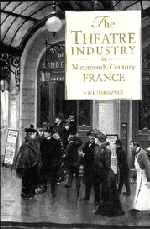Book contents
- Frontmatter
- Contents
- Chronology
- Introduction
- PART I THE AUDIENCES
- 1 Going to the theatre in the nineteenth century
- 2 The auditorium
- 3 Performance times – intervals – annual closures
- 4 First nights and previews
- 5 Order and disorder in the theatres
- 6 Applause and censure
- 7 The claque
- 8 Working-class audiences
- PART II THE ACTING PROFESSION
- PART III THE PROFESSION OF PLAYWRIGHT
- Notes
- Bibliography
- Guide to further reading
- Index
8 - Working-class audiences
Published online by Cambridge University Press: 07 December 2009
- Frontmatter
- Contents
- Chronology
- Introduction
- PART I THE AUDIENCES
- 1 Going to the theatre in the nineteenth century
- 2 The auditorium
- 3 Performance times – intervals – annual closures
- 4 First nights and previews
- 5 Order and disorder in the theatres
- 6 Applause and censure
- 7 The claque
- 8 Working-class audiences
- PART II THE ACTING PROFESSION
- PART III THE PROFESSION OF PLAYWRIGHT
- Notes
- Bibliography
- Guide to further reading
- Index
Summary
The underprivileged urban population of pre-revolutionary France was not by any means deprived of sources of more or less innocent entertainment, both at the fairgrounds and at the various commercial theatres that were started up on the northern boulevards of Paris during the last three decades of the ancien régime. First Nicolet's theatre, later renamed the Gaîté, then Audinot's Ambigu-Comique and several smaller houses were established here, specializing in a repertory primarily aimed at lower-class audiences and priced in accordance with their straitened means. In addition, there was a long-standing tradition of throwing open the larger, more aristocratic theatres to all comers, free of charge, to mark occasions of national rejoicing. Thus, the royal theatres put on free performances to celebrate the birth of a daughter to Marie-Antoinette in 1778 and again at the birth of heir to the throne in 1785. During the Revolution, as part of their efforts to sustain the morale of the sansculottes, the Jacobins resolved to generalize what had been under the monarchy a very sporadic festivity, and instituted, in August 1793, the enactment of named ‘republican tragedies’ for which no admittance charge was made, the theatres concerned being promised an appropriate indemnification. These free performances, known as ‘représentations de par et pour le peuple’, were for a short while of fairly frequent occurrence, the rule being that designated theatres should mount one every ten days (the décade having replaced the seven-day week under the new revolutionary calendar); and these continued under the Directory, though no doubt at a reduced tempo.
- Type
- Chapter
- Information
- The Theatre Industry in Nineteenth-Century France , pp. 117 - 132Publisher: Cambridge University PressPrint publication year: 1993



